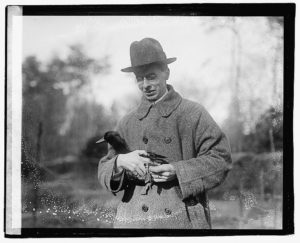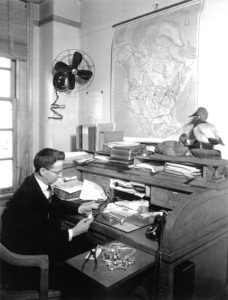The systematic use of bird banding to enhance the conservation of birds was the invention of Frederick C. Lincoln, born on May 5, 1892 (died 1960). From his earliest days, Lincoln loved birds and built an exceptional career from that love.
As a teenager growing up in Denver, he worked summers for the Colorado Museum of Natural History. His supervisor was Alexander Wetmore (who became the Sixth Secretary of the Smithsonian Institution), who taught Lincoln various aspects of bird-craft, including the preparation of bird skins for scientific use. Lincoln liked the work so much that he never attended college, but went straight to work as an ornithologist after high school. By age 21, he had advanced to be Curator of Ornithology at the museum. He worked extensively with Wetmore, including undertaking several field expeditions throughout the southeastern U.S.
During World War I, Lincoln served in the Signal Corps as a carrier pigeon expert. Pigeons were essential for battle-field communication during the war, as telephones and other devices were unreliable. More than 100,000 carrier pigeons were used during World War I—by both sides—providing a 95% reliable communication channel.
Upon his return from military service, Lincoln joined the staff of the U.S. Bureau of Biological Survey (now the U.S. Fish and Wildlife Service) with a very particular assignment: Organize and implement a national bird-banding program for migratory waterfowl. In 1918, the Migratory Bird Treaty Act gave the survey the responsibility for estimating the health of waterfowl populations and setting hunting regulations across the country. The survey needed reliable information.

Lincoln was the man for the job. As colleagues described him, “Fred Lincoln was a rather quiet, studious person…” and “Lincoln approached his task with … characteristic professionalism, thoroughness, vision and dedication….” He combined the pieces of the emerging technique of bird-banding into a continental system with organized numbering schemes, data collection protocols and analytic methods.
The accumulating data about bird movements led Lincoln to propose the concept of migratory flyways, routes that birds generally took when moving between nesting and wintering grounds. The flyway system is now the basis for how waterfowl are managed across North America—and the world. As a colleague described, because of Lincoln’s work “the migration patterns of North American birds are probably known in more detail than is true for any other continent.”

Lincoln also realized that reliable estimates of the total abundance of each waterfowl species was needed annually so responsible hunting regulations could be established. He developed a way to use bird-banding data from the previous year along with estimates of the next year’s hunting harvest to estimate abundance. That straight-forward technique, first described in a survey bulletin in 1930, is now a standard technique in fisheries and wildlife management, known as the “Lincoln Index.”
He authored hundreds of papers during his career, along with several foundational books in ornithology. His contributions were noted in 1956 when the man who had never stepped in a college classroom was presented an honorary doctorate by the University of Colorado. The next year, he received the Department of Interior’s highest award, the Distinguished Service Award.
References:
Gabrielson, Ira N. 1962. Obituary. Auk 79(3):495-499. Available at: https://sora.unm.edu/node/21142. Accessed May 4, 2017.
Lincoln, Fredrick C. 1930. Calculating waterfowl abundance on the basis of banding returns. U.S. Department of Agriculture, Circular No. 118, May, 1930. 4 pages. Available at: https://ia801702.us.archive.org/31/items/calculatingwater118linc/calculatingwater118linc.pdf. Accessed May 4, 2017.
Patuxent Wildlife Research Center. Frederick Charles Lincoln. Available at: https://www.pwrc.usgs.gov/resshow/perry/bios/lincolnfrederick.htm. Accessed May 4, 2017.
Tautin, John. 2005. Frederick C. Lincoln and the formation of the North American bird banding program. USDA Forest Service, General Technical Report PSW-GRT-191:813-814. Available at: https://www.fs.fed.us/psw/publications/documents/psw_gtr191/psw_gtr191_0813-0814_tatuin.pdf. Accessed May 4, 2017.
